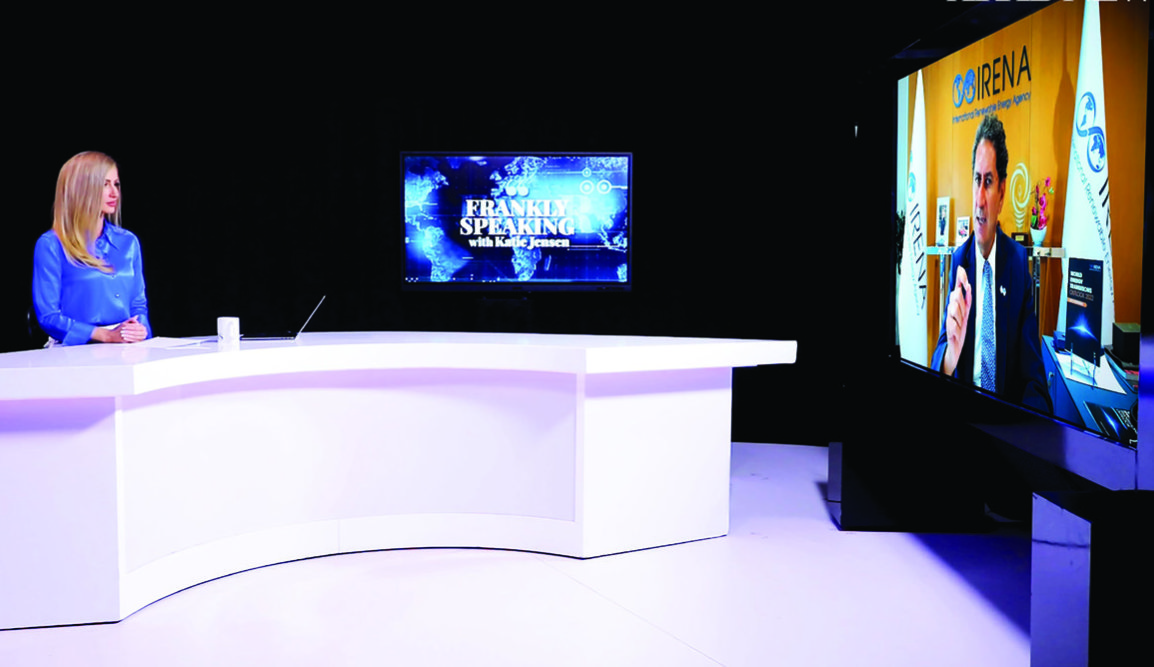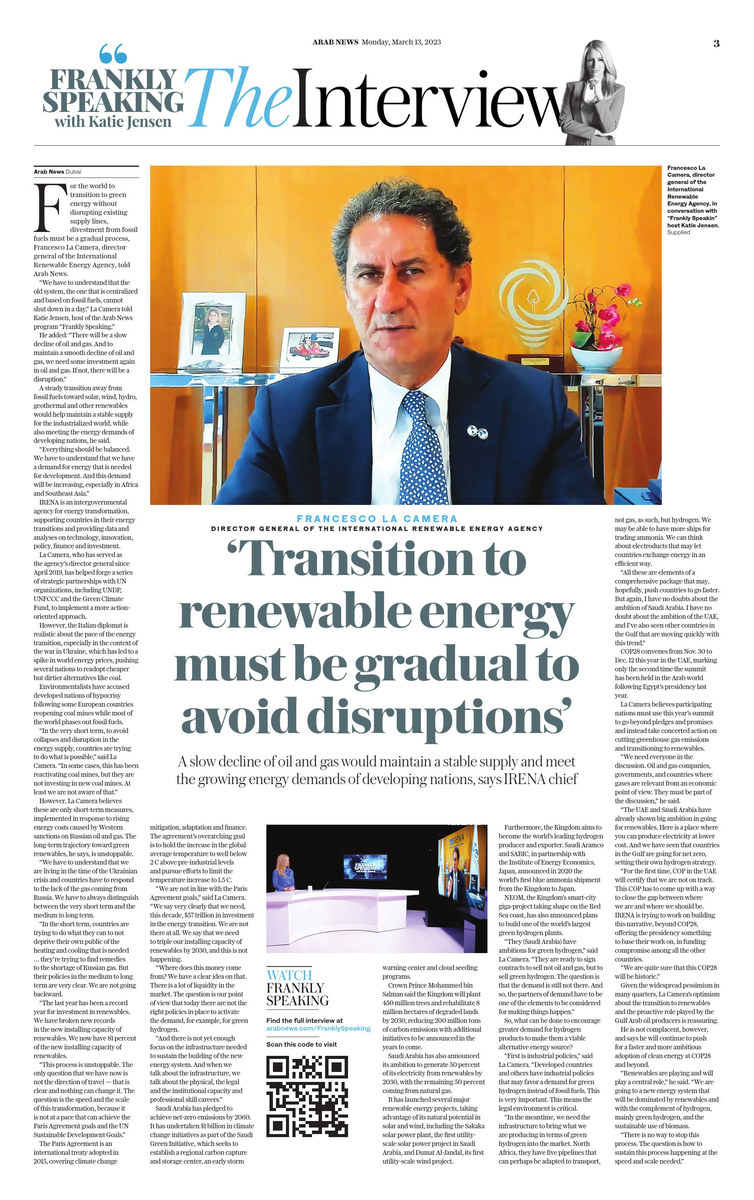DUBAI: For the world to transition to green energy without disrupting existing supply lines, divestment from fossil fuels must be a gradual process, Francesco La Camera, director-general of the International Renewable Energy Agency, told Arab News.
“We have to understand that the old system, the one that is centralized and based on fossil fuels, cannot shut down in a day,” La Camera told Katie Jensen, host of the Arab News program “Frankly Speaking.”
“There will be a slow decline of oil and gas. And to maintain a smooth decline of oil and gas, we need some investment again in oil and gas. If not, there will be a disruption.”
A steady transition away from fossil fuels toward solar, wind, hydro, geothermal and other renewables would help maintain a stable supply for the industrialized world, while also meeting the energy demands of developing nations, he added.
“Everything should be balanced. We have to understand that we have a demand for energy that is needed for development. And this demand will be increasing, especially in Africa and Southeast Asia.”

Frankly Speaking host Katie jensen, left, interviewing Francesco La Camera, director-general of the International Renewable Energy Agency.
IRENA is an intergovernmental agency for energy transformation, supporting countries in their energy transitions and providing data and analyses on technology, innovation, policy, finance and investment.
La Camera, who has served as the agency’s director-general since April 2019, has helped forge a series of strategic partnerships with UN organizations, including UNDP, UNFCCC and the Green Climate Fund, to implement a more action-oriented approach.
However, the Italian diplomat is realistic in his expectations of the pace of the energy transition, especially in the context of the war in Ukraine, which has led to a spike in world energy prices, pushing several nations to readopt cheaper but dirtier alternatives like coal.
Environmentalists have accused developed nations of hypocrisy following recent moves in Europe and the UK to reopen coal mines, at a time when most countries are phasing out fossil fuels.
“In the very short term, to avoid collapses and disruption in the energy supply, countries are trying to do what is possible,” said La Camera. “In some cases, this has been reactivating coal mines, but they are not investing in new coal mines. At least we are not aware of that.”
However, La Camera believes these are only short-term measures, implemented in response to rising energy costs caused by Western sanctions on Russian oil and gas. The long-term trajectory toward green renewables, he says, is “unstoppable.”
He said: “We have to understand that we are living in the time of the Ukrainian crisis and countries have to respond to the lack of the gas coming from Russia. We have to always distinguish between the very short term and the medium to long term.
“In the short term, countries are trying to do what they can to not deprive their own public of the heating and cooling that is needed … they’re trying to find remedies to the shortage of Russian gas. But their policies in the medium to long term are very clear. We are not going backward.
“The last year has been a record year for investment in renewables. We have broken new records in the new installing capacity of renewables. We now have 81 percent of the new installing capacity of renewables.
“This process is unstoppable. The only question that we have now is not the direction of travel — that is clear and nothing can change it. The question is the speed and the scale of this transformation, because it is not at a pace that can achieve the Paris Agreement goals and the UN Sustainable Development Goals.”
The Paris Agreement is an international climate treaty adopted in 2015, covering climate change mitigation, adaptation and finance. The agreement’s overarching goal is to hold the increase in the global average temperature to well below 2 degrees Celsius above pre-industrial levels and pursue efforts to limit the temperature increase to 1.5 degrees Celsius.
“We are not in line with the Paris Agreement goals,” said La Camera. “We say very clearly that we need, this decade, $57 trillion in investment in the energy transition. We are not there at all. We say that we need to triple our installing capacity of renewables by 2030, and this is not happening.
“Where does this money come from? We have a clear idea on that. There is a lot of liquidity in the market. The question is our point of view that today there are not the right policies in place to activate the demand, for example, for green hydrogen.
“And there is not yet enough focus on the infrastructure needed to sustain the building of the new energy system. And when we talk about the infrastructure, we talk about the physical, the legal and the institutional capacity and professional skill careers.”
Saudi Arabia has pledged to achieve net-zero emissions by 2060. It has undertaken $1 billion in climate change initiatives as part of the Saudi Green Initiative, which seeks to establish a regional carbon capture and storage center, an early storm warning center and cloud seeding programs as part of its efforts to create a greener future.
Crown Prince Mohammed bin Salman said the Kingdom will plant 450 million trees and rehabilitate 8 million hectares of degraded lands by 2030, reducing 200 million tons of carbon emissions with additional initiatives to be announced in the years to come.
Saudi Arabia has also announced its ambition to generate 50 percent of its electricity from renewables by 2030, with the remaining 50 percent coming from natural gas.
It has launched several major renewable energy projects, taking advantage of its natural potential in solar and wind, including the Sakaka solar power plant, the first utility-scale solar power project in Saudi Arabia, and Dumat Al-Jandal, its first utility-scale wind project.
Furthermore, the Kingdom aims to become the world’s leading hydrogen producer and exporter. Saudi Aramco and SABIC, in partnership with the Institute of Energy Economics, Japan, announced in 2020 the world’s first blue ammonia shipment from the Kingdom to Japan.
NEOM, the Kingdom’s smart-city giga-project taking shape on the Red Sea coast, has also announced plans to build one of the world’s largest green hydrogen plants.
“They (Saudi Arabia) have ambitions for green hydrogen,” said La Camera. “They are ready to sign contracts to sell not oil and gas, but to sell green hydrogen. The question is that the demand is still not there. And so, the partners of demand have to be one of the elements to be considered for making things happen.”
So, what can be done to encourage greater demand for hydrogen products to make them a viable alternative energy source?
“First is industrial policies,” said La Camera. “Developed countries and others have industrial policies that may favor a demand for green hydrogen instead of fossil fuels. This is very important. This means the legal environment is critical.
“In the meantime, we need the infrastructure to bring what we are producing in terms of green hydrogen into the market. North Africa, they have five pipelines that can perhaps be adapted to transport, not gas, as such, but hydrogen. We may be able to have more ships for trading ammonia. We can think about electroducts that may let countries exchange energy in an efficient way.
“All these are elements of a comprehensive package that may, hopefully, push countries to go faster. But again, I have no doubts about the ambition of Saudi Arabia. I have no doubt about the ambition of the UAE, and I’ve also seen other countries in the Gulf that are moving quickly with this trend.”
COP28, the 28th session of the Conference of the Parties to the UN Framework Convention on Climate Change, convenes from Nov. 30 to Dec. 12 this year in the UAE — marking only the second time the summit has been held in the Arab world following Egypt’s presidency last year.
La Camera believes participating nations must use this year’s summit to go beyond pledges and promises and instead take concerted action on cutting greenhouse gas emissions and transitioning to renewables.
“We need everyone in the discussion. Oil and gas companies, governments, and countries where gases are relevant from an economic point of view. They must be part of the discussion,” he said.
“The UAE and Saudi Arabia have already shown big ambition in going for renewables. Here is a place where you can produce electricity at lower cost. And we have seen that countries in the Gulf are going for net zero, setting their own hydrogen strategy.
“For the first time, COP in the UAE will certify that we are not on track. This COP has to come up with a way to close the gap between where we are and where we should be. IRENA is trying to work on building this narrative, beyond COP28, offering the presidency something to base their work on, in funding compromise among all the other countries.
“We are quite sure that this COP28 will be historic.”
Given the widespread pessimism in many quarters, La Camera’s optimism about the transition to renewables and the proactive role played by the Gulf Arab oil producers is reassuring.
He is not complacent, however, and says he will continue to push for a faster and more ambitious adoption of clean energy at COP28 and beyond.
“Renewables are playing and will play a central role,” he said. “We are going to a new energy system that will be dominated by renewables and with the complement of hydrogen, mainly green hydrogen, and the sustainable use of biomass.
“There is no way to stop this process. The question is how to sustain this process happening at the speed and scale needed.”
























